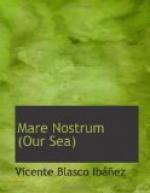Marseilles was the metropolis of the Mediterranean, the terminal for all the navigators of the mare nostrum. In its bay with choppy waves were various yellowish islands fringed with foam and upon one of these the strong towers of the romantic Chateau d’If.
All the crew, from Ferragut down to the lowest seaman, used to look upon this city somewhat as their own when they saw, appearing in the background of the bay, its forests of masts and its conglomeration of gray edifices upon which sparkled the Byzantian domes of the new cathedral. Around Marseilles there opened out a semi-circle of dry and barren heights brightly colored by the sun of Provence and spotted by white cottages and hamlets, and the pleasure villas of the merchants of the city. On beyond this semi-circle the horizon was bounded by an amphitheater of rugged and gloomy mountains.
On former trips the sight of the gigantic gilded Virgin which glistened like a shaft of fire on the top of Notre-Dame-de-la-Garde shed an atmosphere of joy over the bridge of the vessel.
“Marseilles, Toni,” the captain used to say gayly. “I invite you to a bouillabaisse at Pascal’s.”
And Toni’s hairy countenance would break into a greedy smile, seeing in anticipation the famous restaurant of the port, its twilight shadows smelling of shell-fish and spicy sauces, and upon the table the deep dish of fish with its succulent broth tinged with saffron.
But now Ulysses had lost his vigorous joy in living. He looked at the city with kindly but sad eyes. He could see himself disembarking there that last time, sick, without will-power, overwhelmed by the tragic disappearance of his son.
The Mare Nostrum approached the mouth of the old harbor having at its right the batteries of the Phare. This old port was the most interesting souvenir of ancient Marseilles, penetrating like an aquatic knife into the heart of its clustered homes. The city extended along the wharves. It was an enormous stretch of water into which all the streets flowed; but its area was now so insufficient for the maritime traffic that eight new harbors were gradually covering the north shore of the bay.
An interminable jetty, a breakwater longer than the city itself, was parallel to the coast, and in the space between the shore and this obstacle which made the waves foam and roar were eight roomy communicating harbors stretching from Joliette at the entrance to the one which, farthest away, is connected inland by the great subterranean canal, putting the city in communication with the Rhone.
Ferragut had seen anchored in this succession of harbors the navies of every land and even of every epoch. Near to the enormous transatlantic liners were some very ancient tartans and some Greek boats, heavy and of archaic form, which recalled the fleets described in the Iliad.




